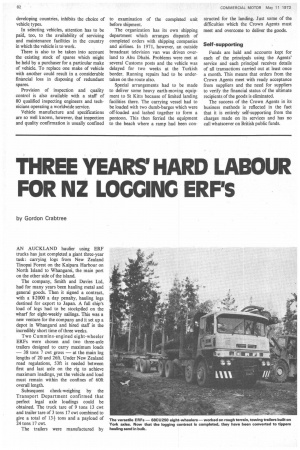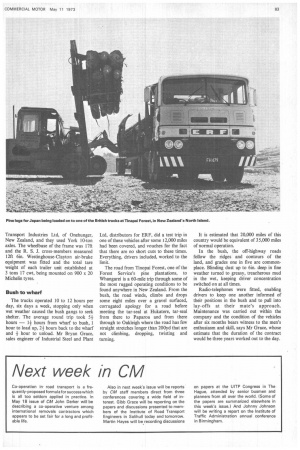THREE YEARS' HARD LABOUR FOR NZ LOGGING ERFS
Page 84

Page 85

If you've noticed an error in this article please click here to report it so we can fix it.
by Gordon Crabtree AN AUCKLAND haulier using ERF trucks has just completed a giant three-year task : carrying logs from New Zealand Tinopai Forest on the Kaipara Harbour on North Island to Whangarei, the main port on the other side of the island.
The company, Smith and Davies Ltd, had for many years been hauling metal and general goods. Then it signed a contract, with a $ 2000 a day penalty, hauling logs destined for export to Japan. A full ship's load of logs had to be stockpiled on the wharf for eight-weekly sailings. This was a new venture for the company and it set up a depot in Whangarei and hired staff in the incredibly short time of three weeks.
Two Cummins-engined eight-wheeler ERFs were chosen and two three-axle trailers designed to carry maximum loads — 38 tons 7 cwt gross — at the main log lengths of 20 and 2611. Under New Zealand road regulations, 53ft is needed between first and last axle on the rig to achieve maximum loadings, yet the vehicle and load must remain within the confines of 60ft overall length.
Subsequent check-weighing by the Transport Department confirmed that perfect legal axle loadings could be obtained. The truck tare of 9 tons 13 cwt and trailer tare of 3 tons 17 cwt combined to give a total of 13-1tons and a payload of 24 tons 17 cwt.
The trailers were manufactured by Transport Industries Ltd, of Onehunger, New Zealand. and they used York 10-ton axles. The wheelbase of the frame was lift and the R. S. J. cross-members measured 12ft 6in. Westinghouse-Clayton air-brake equipment was fitted and the total tare weight of each trailer unit established at 3 tons 17 cwt, being mounted on 900 x 20 Michelin tyres.
Bush to wharf The trucks operated 10 to 12 hours per day, six days a week, stopping only when wet weather caused the bush gangs to seek shelter. The average round trip took 54hours — 1+ hours from wharf to bush, 1 hour to load up, 2+ hours back to the wharf and hour to unload. Mr Bryan Grace, sales engineer of Industrial Steel and Plant Ltd, distributors for ERF, did a test trip in one of these vehicles after some 12,000 miles had been covered, and vouches for the fact that there are no short cuts to these times. Everything, drivers included, worked to the limit.
The road from Tinopai Forest. one of the Forest Service's pine plantations, to Whangarei is a 60-mile trip through some of the most rugged operating conditions to be found anywhere in New Zealand. From the bush. the road winds, climbs and drops some eight miles over a gravel surfaced, corrugated apology for a road before meeting the tar-seal at Hukatere, tar-seal from there to Paparoa and from there through to Oakleigh where the road has few straight stretches longer than 200yd that are not climbing, dropping, twisting and turning. It is estimated that 20,000 miles of this country would be equivalent of 35,000 miles of normal operation.
In the bush, the off-highway roads follow the ridges and contours of the land, and grades one in five are commonplace. Blinding dust up to 6in. deep in fine weather turned to greasy, treacherous mud in the wet, keeping driver concentration switched on at all times.
Radio-telephones were fitted, enabling drivers to keep one another informed of their positions in the bush and to pull into lay-offs at their mate's approach. Maintenance was carried out within the company and the condition of the vehicles after six months bears witness to the men's enthusiasm and skill, says Mr Grace, whose estimate that the duration of the contract would be three years worked out to the day.



























































































































































































































